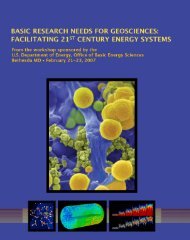Measurement Science Roadmap for Net-Zero Energy Buildings
Measurement Science Roadmap for Net-Zero Energy Buildings
Measurement Science Roadmap for Net-Zero Energy Buildings
- No tags were found...
You also want an ePaper? Increase the reach of your titles
YUMPU automatically turns print PDFs into web optimized ePapers that Google loves.
in<strong>for</strong>mation to “spotlight” or identify poor per<strong>for</strong>ming buildings. Another keylimitation is the lack of data on fault frequency and its impact on energy use.Control systems are an essential enabling technology in intelligent buildings.Advancement of control system technology is impeded by a lack of dynamicsimulation models and robust optimization techniques that work in discontinuoussystems.Non-Technical ChallengesOwnership of building energy use is an overarching challenge. One of the mostcritical barriers to adoption of intelligent building technology is the disconnectionbetween who makes the initial decision to invest, or not, in the energy-efficientsystem and who actually pays the cost or reaps the benefits over time. The centralissue comes down to determining who actually has ownership of the energy use ina building (e.g., the owner, manager, and occupant).Privacy concerns and human behavior are an impediment. Utilities, <strong>for</strong> example,are currently reluctant to share existing data due to privacy issues and areconcerned that data could be used to penalize customers. Fundamentalunderstanding about how occupants and buildings interface ⎯which has manycomplexities based on human behavior⎯is needed and will most likely requireinput and study by psychologists or social scientists. To use intelligent systems,consumers may need incentives other than just cost, such as “cool” gadgetry oraesthetics.D. <strong>Measurement</strong> BarriersA number of measurement barriers and challenges were identified that arecritical to the development and implementation of intelligent buildingtechnologies. These are summarized in Table IV-2 by topical area, with therelative priorities indicated.Some of the most critical measurement challenges include:• Data and methods <strong>for</strong> assessing the per<strong>for</strong>mance of buildings,• Tests and test beds <strong>for</strong> the evaluation of controls technology and faultdetection approaches,• Best practices guidelines <strong>for</strong> intelligent design and operation of buildings,• <strong>Measurement</strong>s to support automation of commissioning processes, and• Low-cost, reliable energy metering systems.Table IV‐2. Intelligent <strong>Buildings</strong> – <strong>Measurement</strong> Barriers and Challenges(● = one vote)Data Sharing and ProtocolsHighPriority• Lack of standards <strong>for</strong> collecting and sharing data ●●●●●●– Standard data <strong>for</strong>mat that enables easy sharing of data– Data protocols <strong>for</strong> all facets of data collection– Lack of standard <strong>for</strong>mat <strong>for</strong> transferring data from systems to analysis tools– Protocols <strong>for</strong> integrating large quantities of sensor data– Clear data ownership⎯defined standards and methodologies to control flow ofdata so building owner can select which data are sent “upstream”26 <strong>Measurement</strong> <strong>Science</strong> <strong>for</strong> <strong>Net</strong>-<strong>Zero</strong> <strong>Energy</strong> <strong>Buildings</strong>
















